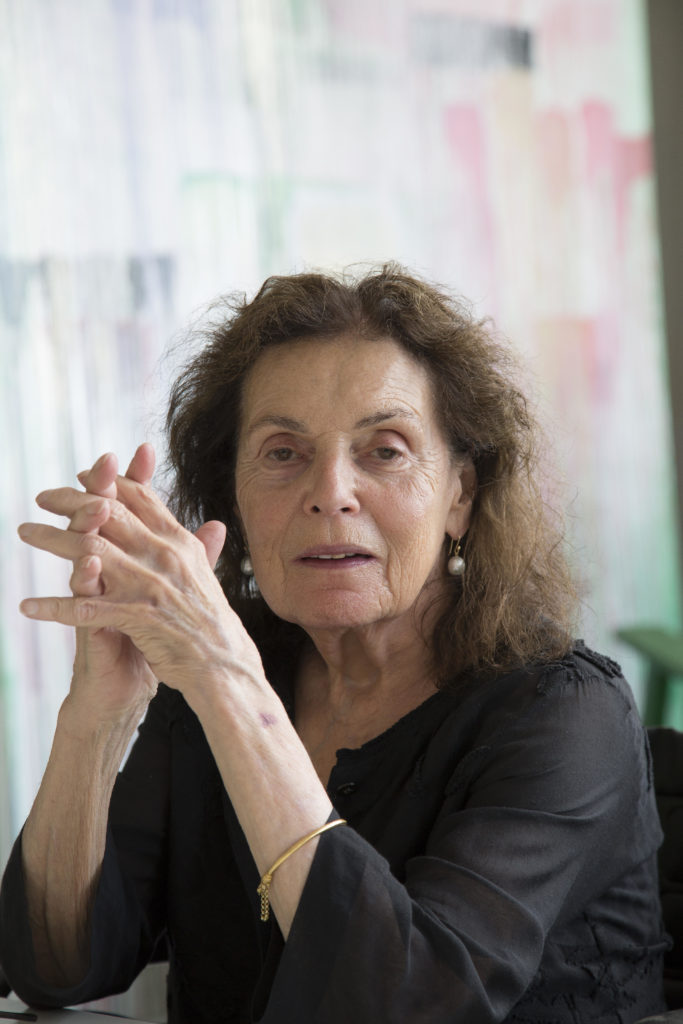Art & Exhibitions
Pat Steir Will Make Monumental Waterfall Paintings for Both the Barnes and the Hirshhorn in 2019
The commissions are the latest coup for the 78-year old artist, whose career is on a hot streak.

The commissions are the latest coup for the 78-year old artist, whose career is on a hot streak.

Eileen Kinsella

Artist Pat Steir has a big year ahead in 2019.
In January, the Barnes Museum in Philadelphia will unveil “Silent Secret Waterfalls: The Barnes Series,” a monumental commission for the museum’s Annenberg Court entrance, where it hosts events. And in October, the Hirshhorn Museum and Sculpture Garden in Washington, D.C. will present her largest site-specific commission to date: 28 new paintings that will span nearly 400 feet around the museum’s inner-circle gallery.
“I’m happy to be busy always, and thrilled to take this on,” Steir told artnet News in a phone interview. “It’s nice to have it so clearly framed what I have to do for the next year.”
These major commissions are just the latest coup for the artist, whose career has taken off after decades of steadily growing recognition from critics and collectors. Steir, who was born in 1940 and experimented with conceptual art, Minimalism, and figuration for yeas, has now become famous for her “Waterfall” paintings. She began making them in the late 1980s, inspired by a mix of East Asian art, Zen Buddhism, and Taoist philosophy that led to a more performative approach to painting. More recently, Steir has been creating large canvases that appear as though light is breaking though from behind.
Of the Barnes commission paintings, she says, “they’re different than the ones I did before, but they’re the same.”
There are 11 paintings in total, each seven feet tall. Steir explained that the Annenberg Court walls contain 11 indentations with silk stretched over it. The heights are identical at seven feet each, though the widths vary and all will feature her waterfall paintings.
When Barnes director Thom Collins invited her for the commission, “he specifically asked for the ‘Waterfall’ paintings because he thought they would reverberate,” she says. “My reaction was ‘yes, yes yes, I can’t wait to do this!’ ”
“Pat Steir is an absolute force,” said Collins in a statement. “One of the very few women who came to prominence as a painter in the New York art world of the 1970s, she made her mark with works that paired iconic images and suggestive texts, posing questions about the nature of representation.”
Having grown up in a suburb of Philadelphia, Steir recalls the original Barnes Museum, which was housed in the residence of founder Dr. Albert C. Barnes. “The museum was hard to get into at that time. But I was an art student so I wanted to see the art. It was very mysterious then because it was a man’s house… it was like getting in to the lion’s cave or something.”
Years later, when the museum re-opened in its new, and most would say far-more-welcoming home on the Parkway in Philadelphia, the artist attended the opening with friends and said her initial thought was: “I’d like to do something in that space… I thought, specifically, that my waterfalls would look good in this space.”
Now, years later, her wish is coming true.
The Hirshhorn Museum project has a different angle, even though this too will consist of “Waterfall” paintings. The style and presentation, shaped in part by the circular format of the gallery, will reflect the artist’s fascination with colors and color wheels.
“I’m making a color wheel in that space of paintings that relate to each other the way opposites do,” says Steir. When presented as a group, the 28 paintings will create a monumental color wheel that shifts hues with each painting. The pours on each canvas often appear in the complementary hue of the monochrome background.
The Hirshhorn invitation came from senior curator Evelyn Hankins. Steir was one of 31 female artists honored at the Hirshhorn’s gala last year, and this project marks her first solo exhibition in Washington, D.C. in nearly 50 years.
Museum director Melissa Chiu said that the artist’s “signature, multilayered canvases have time and again redefined what it means to be a contemporary painter.”
For her part, Steir says she is “thrilled” about the Hirshhorn project and plans to get started on it soon, as she’s nearing completion of the Barnes works. “It’s a really exciting project. I can line the paintings up in my studio as I paint them and see the color gradations while I’m doing it. I can see the project evolve clearly.”